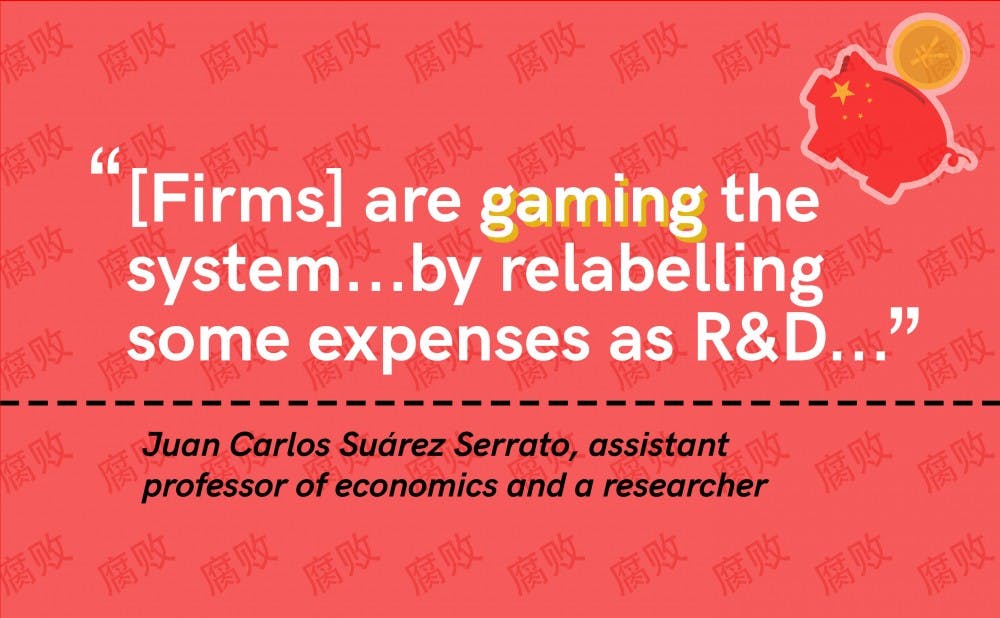A Duke economics study found that more corporations are taking advantage of China's policy to incentivize research and development investment through tax cuts by relabeling their expenses as research and development, adding to the fiscal cost of the government.
Because subsidizing research and development precipitates an increase in all-around economic productivity, China utilizes different research and development percentage thresholds, decided based on the size of the corporation—at which companies earn tax cuts—for their investments in research and development, according to the research team.
"[Firms] are gaming the system a little bit by relabeling some expenses as R&D even though they're not real research and development,” said Juan Carlos Suárez Serrato, assistant professor of economics and a researcher on the study.
Because subsidizing research and development precipitates an increase in all-around economic productivity, China utilizes different research and development percentage thresholds, decided based on the size of the corporation—at which companies earn tax cuts—for their investments in research and development, Suárez Serrato said.
The tax cut at various thresholds is discontinuous, allowing companies to pay significantly less tax once their research and development expenses reach a different threshold, he explained.
“It’s kind of like a big jump, [which] is called a notch.” Suárez Serrato said. “What we find is that firms respond to this notch by reporting that they do more research and development...With such a tax cut 'going from 25 percent to 15 percent, you can keep 10 percent more of your profits.'"
In addition to increasing their profits, companies may also be motivated to relabel their expenses to ensure they remain eligible for tax returns, Suárez Serrato added. The tax cut policy operates under a fiscal program called InnoCom, which requires firms to allocate a certain percentage of their annual sales on research and development.
“In some years, if [firms] sell too much relative to the research and development that they did, they might be in danger of not complying with the program,” Suárez Serrato said. “So at that point, even though they planned to do real activities, they might need to—for that year, to not fall off the program—to relabel.”
The Chinese government reformed the InnoCom program in 2008 to include smaller companies to participate and change the notch location. Companies must be pre-registered and pre-audited in order to participate.
To track what percentage of reported research and development was a product of relabelling, Suárez Serrato and his research partner—economics professor Daniel Xu—collaborated with Chinese businesses to analyze the research and development happenings. After analyzing the data, they found that there a significant number of companies clustering at each of the notches, strongly indicating many of them have relabelled their expenses.
It would take a few years to develop an accurate mathematical model to evaluate the data due to the difficulty in determining what constitutes as real research and development growth, Suárez Serrato noted.
“[It’s] a little bit of a complicated calculation because we need to basically estimate a model where firms are deciding to invest in research and development and where firms are deciding to relabel,” he said.
Based on a structural model where firms are making these joint decisions about investing and relabelling and according to this model, Suárez Serrato and his peers estimated about 30 percent of the reported research and development increase is a result of relabeling.
Countries adopt diverse policies to incentivize research and development to achieve a higher overall productivity in the society in the long run, Suárez Serrato said.
“The government wants to encourage research and development because research and development has what we call positive externalities—when you develop a new idea or a new method of production, another company might adopt it and that might make that other company more productive," he added.
In the United States, the tax credit system for research and development investments follows a steady, graduated pattern instead of concrete percentage thresholds, as it is in China. Because of the form that China’s policy takes, there is an exceptionally large incentive to invest in research and development and perhaps also a greater chance for counter-productivity and loss of government revenue through the relabelling of research and development.
“If you're giving people money to incentivize them to do research and development, but say to the extreme when it's all relabelling, you don't actually have any of the positive externalities,” he explained.
Despite the relabelling, the tax-return policy has generated true research and development increase, and thus, true productivity increase and economic growth, Suárez Serrato said.
What their research divulges is that actual productivity and returns from research and development investment may not be up to par with the reported numbers.
“We can't say whether or not [the policy] is good or bad,” Suárez Serrato said, “we're just saying that [the relabelling] aspect of it is making it more costly than you otherwise would think."
Get The Chronicle straight to your inbox
Signup for our weekly newsletter. Cancel at any time.

Mona Tong is a Trinity senior and director of diversity, equity and inclusion analytics for The Chronicle's 117th volume. She was previously news editor for Volume 116.

